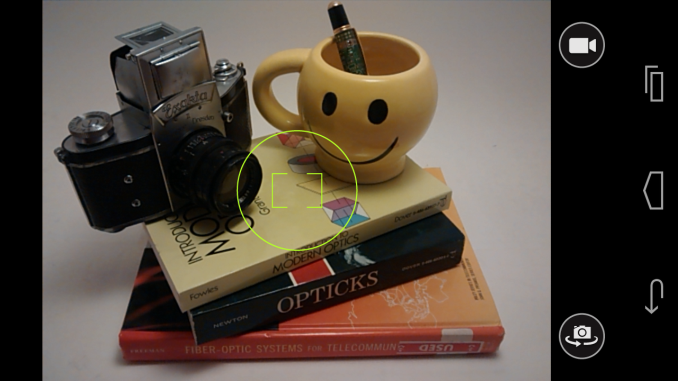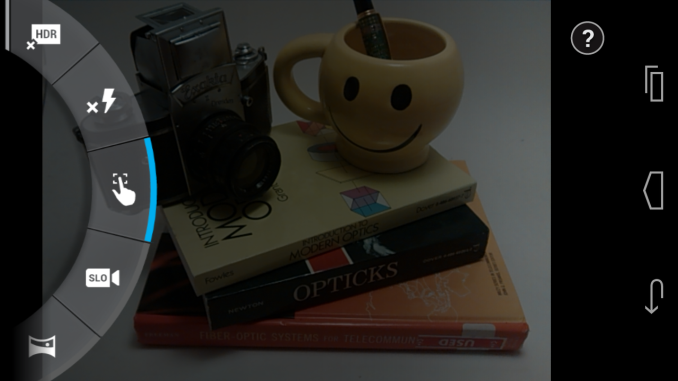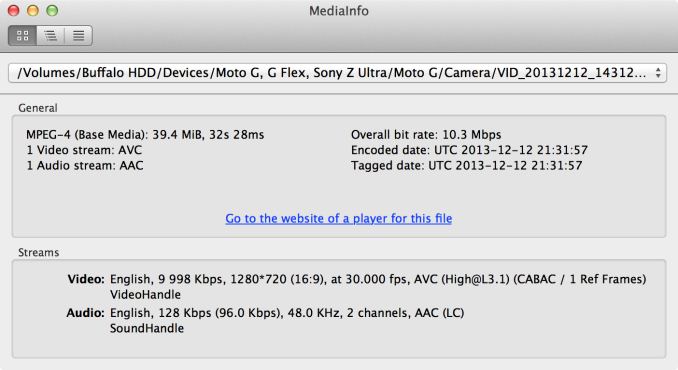Motorola Moto G Review
by Brian Klug on December 18, 2013 2:00 PM EST- Posted in
- Smartphones
- Motorola
- Mobile
- *VA
- Cortex A7
- snapdragon 400
- Moto G
On the camera side the Moto G includes a 5 MP rear facing camera with autofocus and LED flash, on the front it includes a 1.3 MP camera. I did some digging and found that the rear facing camera CMOS is an Aptina AR0543 CMOS. There’s nothing on Aptina’s website about the AR0543, but there is an AR0542 which probably is its predecessor with 1/4 Inch format and 1.4 μm pixels. I suspect this is exactly the form factor of the sensor in Moto G, with some slight improvements, I believe the color filter array is Bayer as well, not RGBW like Moto X. The rear facing camera module has a focal length of 3.5 mm which works out to around a 37mm focal length in 35mm-equivalent units, the system has an F/# of 2.4, which is great for a device of this cost.
On the front is the Aptina MT9M114 1.3 MP, 1/6 Inch with 1.9 µm pixels sensor that we’ve seen a lot of in recent days.
Motorola uses the same camera application as the Moto X, and reflects the most recent UI changes that have rolled out in both OTAs and through the Play Store. The biggest change is a new spot focus and exposure point which can be dragged around the live preview. Motorola calls it manual focus and exposure, in practice it’s really a weighted spot meter and focus point that you can drag around. I’d only call what LG has on the G2 or Nokia bundles as manual focus, but the new camera app is a substantial improvement over the UI as it launched with the Moto X, which didn’t afford any exposure or metering controls (instead taking a scene average), only tap to focus, which ran a full AF search wherever you tapped.
The camera settings menu still is a ring chooser that slides out with a drag from the left side, and has settings for HDR, flash, tap to focus/expose, slow motion video, panorama, location, a new aspect ratio toggle (16:9 and 4:3) and shutter sound. The aspect ratio toggle is what’s new versus the X, since the Moto G has a standard 4:3 aspect ratio sensor and not the 16:9 aspect ratio aspect ratio of the Moto X. By default the Moto G launches with the 16:9 aspect ratio for image capture, cropping off part of the image area, but tapping 4:3 gives you a proper live, full field of view, 4:3 preview. Major kudos to Motorola for giving an aspect-correct live preview. Shot to shot latency is longer than Moto X or other flagships, but not inordinately long or on the order of seconds. I should note that the Moto G does not include the same wrist-flick camera activation gesture as the Moto X.
To evaluate image quality we turn to the usual combination of photos taken at the bench locations, although location 7 wasn’t available, and photo tests in a lightbox with lights on, and off, and of test charts. I also continue to take photos while out and about with devices to get samples in a variety of other conditions.
Moto G still image quality is better than I had suspected. Outdoors in well lit scenes the Moto G is totally capable of delivering good quality shots with good exposure and focus.
My only major criticism is that there’s definitely some off-axis loss of sharpness, the leftmost part of almost every image gets blurry quickly, the right side doesn’t show nearly as much. Alignment tolerances for smartphone optics are a part of module cost, I wouldn’t be surprised to see variance like this. In low light or indoors, the Moto G occasionally struggles to produce images without blur, but that’s a complaint I still levy against some modern flagships. There’s also a bit of light leakage on the Moto G which crops up when outdoors, but nothing crazy. Front facing camera quality is totally par with other flagships I’ve tried, which isn’t surprising.
Camera - Video
On the video side, the Moto G’s interface is, no surprise, just like the Moto X. There’s a video button that immediately starts video capture, successive taps in the image area capture still frames from the live video. Although MSM8x26 supports up to 1080p30 video encode for H.264, Moto G oddly enough captures video at 720p30 in H.264 High profile at 10 Mbps. Audio is stereo thankfully at 128 kbps AAC.
As always I’ve uploaded a copy of the video recorded at the usual place to YouTube and to our servers for you to look at without the additional compression.
Video from the Moto G is well exposed and appears great for being 720p. I would personally miss 1080p, but the Moto G seems great for the resolution it affords. There’s no dropped frames or visible macroblocking, and exposure seems good, again my only desire would be for 1080p resolution.























































120 Comments
View All Comments
uhuznaa - Wednesday, December 18, 2013 - link
Even my 8 GB Nexus 7 has a two GB left. Lots of storage is convenient for the lazy and the horders, but in now way something that makes or breaks a device for "normal" use. "3-4 GB of music" is about 1000 songs. Yeah, more is better, always, but don't make this into more of a limitation than it actually is. Most people don't care very much anyway.apertotes - Wednesday, December 18, 2013 - link
a tablet is not at all like a phone. a tablet sits at home mostly, with WiFi and instant access to hundreds of online services. A phone goes with you everywhere, even places without -gasp- internet. And most people care, indeed, and that is why they buy galaxies instead of ones.Bob Todd - Wednesday, December 18, 2013 - link
Do you have any proof that the majority of Galaxy S* buyers do so because of micro-SD or removable batteries? Survey data from a reasonable cross section of buyers? I like both of those features, but the idea that it is the main driver of Samsung's success with that line doesn't seem to be grounded with any facts. I'd assume marketing plays the biggest role, along with actually building a solid brand behind it (one high end line available on most major carriers updated once per year). Yes some % of users care a great deal about removable storage and removable batteries, but if you think that's the secret to their success I think you are deluding yourself. And I'm almost sorry I responded at all to the inevitable whining about removable storage. There are other cheap devices that offer those features, be happy that a quality option is available at this price point.apertotes - Wednesday, December 18, 2013 - link
Well, HTC thought the same last year, after their beautiful HTC ONE X beat the Galaxy S3 in every review, but lost badly on sales. "It's the marketing!". They lost another good year blaming marketing, and now are even in worse situation than a year ago. Or do you want to convince me that HTC is not a strong brand? Or Blackberry, for what it is worth.Yes, Samsung sells lots of Aces very cheap, but S3 and S4 and Notes are not cheap. And they outsell almost the rest of high end android devices combined. I really do not think that Samsung is that good at marketing.
Impulses - Wednesday, December 18, 2013 - link
Nope, HTC isn't a very strong brand outside of tech enthusiasts. Samsung/Galaxy is a lot more easily recognized... I had three HTC phones in a row (all the EVOs), very early random people would ask me if they were "the new iPhone" (never mind the massive size difference). Later on most friends would ask "did you get a Galaxy?" when they'd see I have a new phone, never mind it says HTC front and center...Samsung is ABSOLUTELY that good at marketing, have you watched network TV or looked at print magazines lately? Geeks may not do that much anymore but the general public does and Samsung's ad campaign is all over that media, it's impossible to ignore.
sajara - Saturday, December 21, 2013 - link
Indeed you're absolutely right. Samsung is a very powerful brand just about everywhere due to marketing. That, produces free publicity through brand awareness and then word of mouth. Even in the Dominican Republic a (developing country) where i go regularly, a sacred Blackberry land, is buying in bulk Galaxy(s) and why? Huge billboards everywhere and all 4 carriers selling just about every model.sajara - Saturday, December 21, 2013 - link
I was referring to Impulse's post btw...Bob Todd - Wednesday, December 18, 2013 - link
Again, what proof do you have to the contrary? Like I said, I'm sure some % of their user population does buy the Galaxy line _specifically_ for micro-SD and a removable battery. But I'd put a decent chunk of change on the size of that % being 1 in every 5 buyers or less. You think all those buyers of a mainstream device (who have no idea what SOC is in their phone or even what a SOC is) are walking into their carrier's stores with a 64GB micro-SDXC card full of stuff? There is a lot more to the success of the Galaxy line than removable batteries and expandable storage.apertotes - Wednesday, December 18, 2013 - link
I do not need to give any proof at all. I am not in the industry, and I could not care less. But it is funny watching people that should really know about this stuff (like HTC spokesperson) blame it all on marketing time after time, and get worse results every year.Also, HTC is a very strong band. A few years ago it was almost a synonym of smartphone, and they also spend a lot of money on advertising and sponsorships.
Anyway, do you have any proof that micro-sd cards are not a strong reason behind massive galaxy sales?
martajd - Wednesday, December 18, 2013 - link
"I don't need to give any proof." Yeah, you do